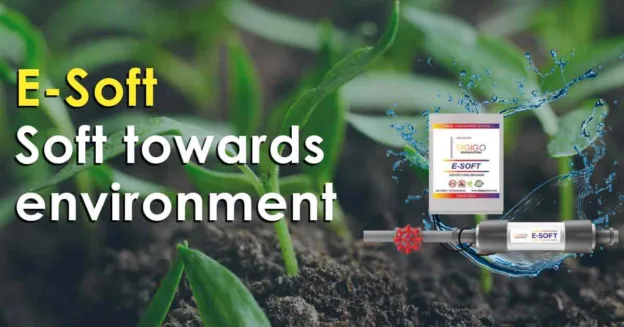Contents
Why the Problem of Hard Water Emerged?
Over the years, hard water has become a major issue across the world. Hard water contains high amounts of minerals like calcium and magnesium. As population and construction have increased, groundwater sources have become contaminated with these minerals from soil and rocks. With more people and less usable water, this creates big problems.
The government has known about this since the 1970s. Studies found that 70% of household people deal with hard water issues. But more progress has yet to be made in solving the problem. Consumer-level water-softening solutions are greatly needed!
Hard Water Effects on Various Sectors
Agriculture
The bigger size calcium and magnesium minerals stick to the surface of the soil. Hence they stop the necessary nutrition to reach the roots of crops. Eventually, roots become weak and the plants stop growing. Because of weak roots plants get diseased and therefore farmers often have to use more fertilizers, pesticides and insecticides which increases costs. Minerals in hard water can reduce wheat and rice crop yields by 25-60% compared to soft water. The minerals also build up in the pipes, sprinklers, and drippers hurting the whole irrigation system.
Residential
In urban and rural homes, hard water leaves mineral deposits on sinks, bathrooms, taps, showers and appliances. It clogs pipes and makes soaps less effective. Women face most of this work burden. Many families also don’t like the taste of hard water for drinking and cooking. They have to buy bottled water. Household wastes huge amounts of money to solve hard water problems in their homes.
Commercial
From hotels and restaurants to hospitals and schools, hard water causes complications for the commercial landscape. Guests expect high quality water for bathing, laundry, and food/beverages. Medical facilities require purified water for dialysis, equipment sterilization, and medications. Buildup in large-capacity heating, ventilation, and AC systems leads to high repair costs. Water quality impacts customer perceptions and increases operating expenses across sectors.
Industrial
Factories and infrastructure rely heavily on water. But over time, untreated hard water corrodes metal pipes, boilers and cooling tanks. This causes breakdowns, expensive replacements and lost productivity. Manufacturing quality also needs to improve with properly softened water. Overall, hard water greatly increases production costs and energy bills.
Growing Water Crisis
Experts warn that water problems will get much worse in the next 15-20 years if major investments are not made soon. Failed monsoons, climate change, pollution and overusing limited water supplies all put more pressure on the little usable water that remains.
Demand for drinkable water is expected to be twice as high as the supply by 2030 when India’s population will exceed 1.5 billion. Groundwater, which currently provides 40% of India’s water, is running out in major states like Punjab, Rajasthan and Maharashtra. What little is left will have more contamination as groundwater levels sink deeper.
Surface water will become more unpredictable and get more polluted too, making it unfit for drinking or farming over huge areas. Over 600 million people may face extreme water shortage, with no usable water available nearby. This will cause major public health issues from lack of clean water for drinking and sanitation.
Initiatives for Clean Water
Many new efforts across the world aim to develop and expand technologies to detect, treat, and monitor water quality issues in urban and rural areas.
Past large-scale water softening efforts did not sufficiently reach many households needing it. They lacked widespread access, efficiency, and rural reach.
1st Generation: Salt-Based Softeners
The earliest water softeners from the 1900s used salt to remove hardness minerals like calcium. But they created waste and needed maintenance.
2nd Generation: Ion Exchange Resins
In the 1950s, resins were developed to replace salt for softening. They also removed hardness but needed occasional regeneration.
3rd Generation: Magnetic Water Treatment
In the 1980s, magnets supposedly rearranged molecules to reduce hardness. However their effectiveness was disputed, only reducing around 20% hardness.
4th Generation: Computerized Conditioners
In the 2000s, automated magnetic conditioners improved effectiveness to around 50%. However, questions remained about long-term impacts.
New water testing tools are helping detect quality issues. And technologies continue improving softening effectiveness. But further innovations are still needed for sustainable, widely accessible solutions.
DIGIGO E-Soft: 5th Generation of Water Softener
E-Soft signifies Indian R&D matching global water treatment innovation for national challenges. Digigo developed the E-Soft water softener system, using customized low-frequency electronic pulses to break the bigger size minerals into microns and soften water. It unlocks the full potential of electronic softening for clean water across applications. With its breakthrough Made in India E-Soft water softening technology, Digigo sets a new standard in sustainable softening without the limitations of past generations.
E-Soft pulses interact with hard minerals like calcium to permanently neutralize their charge. It achieves 100% softening without removing dissolved solids. The water retains nutrition and flows freely without scale buildup. E-Soft water softener needs no chemicals, salt or consumables, making it eco-friendly. It requires less maintenance, saving users time, effort and money.
E-Soft: Environmental Sustainability
E-Soft water softener transforms hard minerals into plant nutrients, eliminating fertilizers. This enables chemical-free agriculture with softened water. Runoff also prevents pollution and improves soil health.
In homes, E-Soft water softener for home prevents scale buildup, improving appliance performance. This saves up to 30% of water and electricity wasted on hard water damage yearly.
For companies, E-Soft extends system and machine life by protecting against damage. This conserves resources by delaying replacements and reducing manufacturing and scrapping.
Most importantly, E-Soft maximizes the usability of available water supplies, easing the strain on groundwater. Better quality water access also strengthens community climate resilience and health.
Join the Green Water Revolution
As India struggles with intersecting hard water prevalence and sustainability challenges, the E-Soft water softening system presents a timely innovation to simultaneously tackle environmental pressures and uplift household access to softened water’s benefits. By pioneering sustainable electronic water softening, E-Soft ushers in a new era for eco-conscious water treatment.
